Lose Your Holiday Weight: Walk Your Dog!
Dogs
The holidays are over. That means no more parties, no more elaborate turkey dinners, and no more holiday treats making a beeline for your hips. If you have picked up a few pounds that weren't on your wish list, don't despair; there is a simple solution: Get out and exercise.
Given the choice between doing sit-ups and walking your dog, you'd probably grab the leash and head for the door. And why not? Your waistline can't tell the difference. Any physical activity you do on a regular basis will help you slim down and firm up.
Exercise gurus suggest that using the buddy system is a great way to keep motivated to stick to an exercise program and lose weight. Often the hardest part of any program is getting started, but when a "buddy" is depending on you to get off the couch and out the door – in fact, standing there with pleading eyes and his leash in his mouth (sound like anyone you know?) – you are more likely to do it.
Learn From Your Dog
Dogs think exercise is fun. Dogs do not use the snooze alarm to give them "just 5 more minutes" before they get up out of bed and out the door. They do not have a little voice speaking to them from within and saying things like, "You exercised yesterday – today you need a break," or "You can go later when you're not so busy," or "It looks like rain – better wait."
All dogs require exercise – even the small breeds. Some dogs are bred for work or sport and demand vigorous exercise. But your dog needs a buddy, too. If left alone or confined to a fenced yard, he will not exercise either. And an unexercised dog is an unhappy dog, an unfit dog and very often a badly behaved dog.
Benefits of Exercise
Exercise has many benefits, the most obvious being that it keeps your body toned and healthy, gives you energy, and makes you feel better. For all the same reasons, your dog needs to get up and get moving, too. Here are some other benefits that you shouldn't overlook:
Exercise helps you control excess body fat and lose weight. Of course, this is often the most important aspect of an exercise program. Granted, you also need to cut back on your caloric intake a bit; but studies have repeatedly shown, that people who combine a sensible diet with regular physical activity are not only more successful in losing excess weight; they are usually more successful at keeping that weight off.
The key to losing body fat is for you to decrease your caloric intake by 500 calories a day. You can do this with a combination of calorie reduction and exercise. After one week you will have decreased your intake by 3,500 calories, which will result in the loss of one pound of fat. In other words you can lose one pound a week.
It is believed that 30 minutes or more of low-intensity exercise could burn more calories and body fat than brief high-intensity exercise – up to 240 calories an hour. Furthermore, breaking up exercise sessions into shorter bouts, perhaps 10 minutes four times a day, can foster as much or even more weight loss as exercising 40 minutes at a time.
Exercise controls appetite. Studies show that vigorous exercise acts as a temporary appetite suppressant. As an added bonus, when appetite returns, caloric intake does not compensate for caloric expenditure.
Exercise changes the way the body processes food. Ideally, food should be used as energy rather than being stored in the body as fat. However, sedentary people tend to store excess calories as fat instead of using it for energy.
Exercise increases your metabolic rate both during and up to 48 hours after exercising. Muscle tissue is far more active than fat tissue and even when a person's muscles are at rest, they are actively consuming energy. A person's metabolism speeds up in order to provide muscle tissue with this energy.
Exercise also preserves muscle tissue – the only place where calories are "burned." A greater percentage of muscle vs. fat increases the number of calories you use daily. To lose body fat effectively, you must become a calorie consuming, fat burning, exercise machine.
Exercise reduces stress and boredom for you and your dog. Insufficient exercise as well as not enough of your attention can contribute to problem behaviors including chewing, digging, garbage raiding, hyperactivity, unruliness, excitability, attention-getting behaviors, and even some forms of barking. Everyone needs a change in scenery and this is true for both you and your dog. Getting some quality outdoor time can benefit both of you.Hit the Road
Fitness walking is different from your ordinary stroll, so you should work into it gradually. You will obtain benefits by walking at a 15- to 20-minute mile, but if you haven't been exercising regularly, you may not be able to move that fast right away. Even if you take 35 minutes to walk that mile, you will improve with time – and you'll still reap the benefits.
If your dog hasn't exercised regularly in the past, he will need to ease into a regular fitness program, too. Have your veterinarian check his physical condition, then keep your eye on him as you exercise; rapid breathing, bright red gums, and lagging behind may be indications that he is fatigued.
Most walking programs suggest the following method:
Start with short walks and gradually work into longer exercise sessions. Again, four 10-minute sessions is just as beneficial as one 40-minute stretch.
Start out slowly and work up to a brisker pace. Keep your steps short and fast. The faster you move, the better your cardiovascular workout; however, don't walk faster than your comfort level allows. You should be able to carry on a conversation without getting out of breath. Maintain an even stride and a steady pace.
Stand up straight and look ahead. Keep your shoulders back and relaxed, chest lifted and tailbone pointing toward the ground. Keep your dog close at your side. Swing your arms naturally at your sides for balance and movement.
Your heel should be the first part of your foot to touch the ground. Then roll through the ball of your foot and push off with your toes. This motion reduces shin splints and tendon pulls.
Precautions
Bring enough water for you and your dog.
Unless you are in an isolated area, keep your pet on a leash as you walk. Even the best trained dogs often bolt into the path of an oncoming car or become interested in other animals.
Avoid walking in extreme weather – keep sessions short if it's too cold, too hot or too stormy. During summer, avoid walking during the hottest parts of the day. The best times are early morning, late afternoon or evening.
If you walk at night, put reflectors on your pet's collar as well as your own clothes.
Avoid hot pavement or rocky terrain. If it is uncomfortable for your bare feet, it is probably uncomfortable for your dog's foot pads. Try to walk on dirt paths or grass as much as possible. If your dog shows signs of soreness or has trouble getting to his feet, stop walking and take him to your veterinarian.
Before you walk, let your dog sniff and "mark" (urinate) outside for a while, so that he won't need to stop often. If he does stop, a "no" and a gentle but firm tug on the leash should get him moving again, and soon he will get used to walking without stopping.
If your dog has more energy than you, try tossing a Frisbee for a while. This can use up 250 to 350 calories an hour, and even more if it's strenuous.
As you begin this new year, make a commitment to yourself and your pet. Exercising with your dog is a great way to strengthen the bond between you. As an added bonus, you'll be exercising, your dog will be exercising, and you will both be enjoying quality time together.

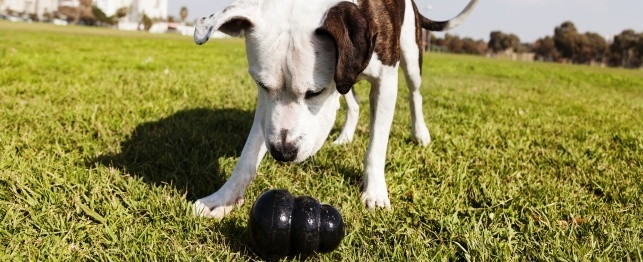 Commercial Brain Games Challenge Your Dog
Commercial Brain Games Challenge Your Dog
Commercial Brain Games Challenge Your Dog
Commercial Brain Games Challenge Your Dog
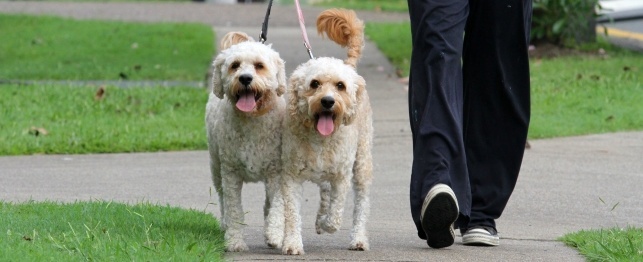 How Much Exercise Does My Dog Need?
How Much Exercise Does My Dog Need?
How Much Exercise Does My Dog Need?
How Much Exercise Does My Dog Need?
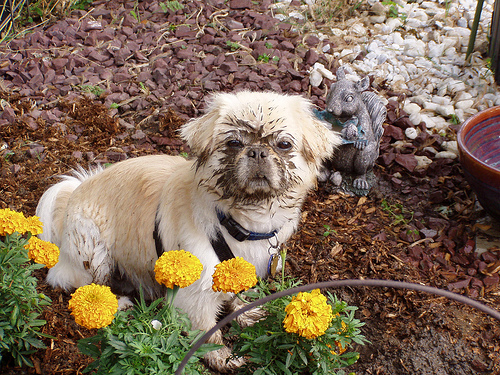 How To Deal With Dogs That Dig
How To Deal With Dogs That Dig
Digging can be a fr
How To Deal With Dogs That Dig
How To Deal With Dogs That Dig
Digging can be a fr
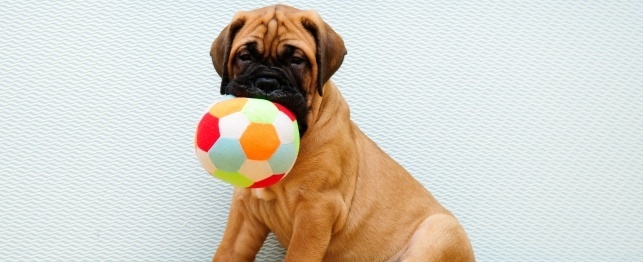 Doggie Day Care
Doggie Day Care
Doggie Day Care
Doggie Day Care
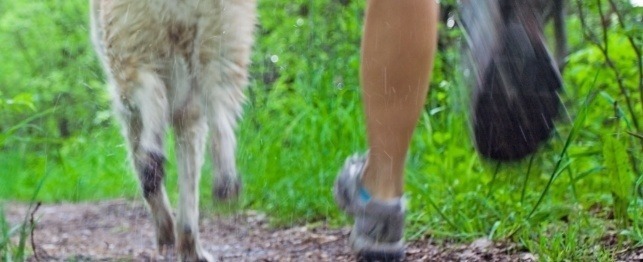 Does Your Dog Need More Exercise?
Does Your Dog Need More Exercise?
Does Your Dog Need More Exercise?
Does Your Dog Need More Exercise?